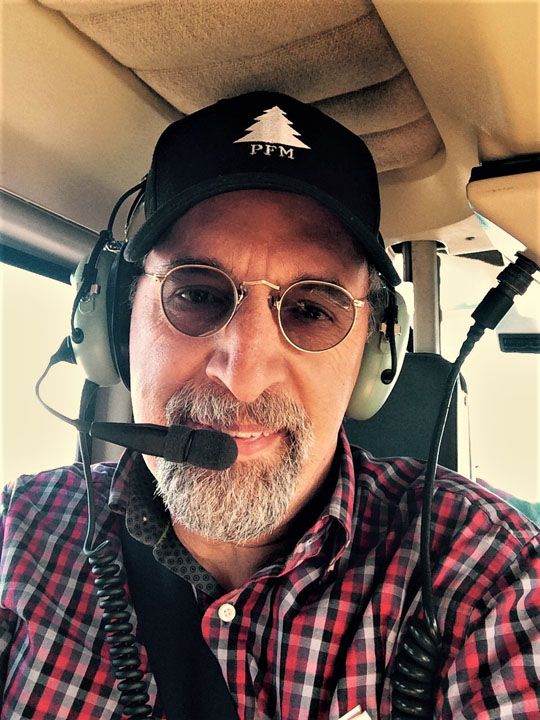The Death of the Forest Service
Utah Senator Mike Lee Wants to Kill the U.S. Forest Service We understand Senator Mike Lee’s anger over

“Blowtorch Forestry” is one of the most explosive interviews to ever appear on Evergreen's website. Frank Carroll, a Colorado forester and wildfire expert, speaks with Evergreen founder, Jim Petersen, concerning his assessment of "First, put out the Fire!" Carroll enjoyed the book, but wished Petersen had more thoroughly covered “managed fire.”
To that end, the following documents accompany this interview:
A data rich, science based essay titled Wildfire Forestry: Managing National Forests with Unplanned Fire, written by Carroll and his partner, Van Elsbernd.
A study titled, Increasing Workforce Capacity, prepared in 2019 by the National Association of U.S. Forest Service Retirees, that exposes the Forest Service’s alarming shift in hiring practices – a shift highlighted by Carroll and Van Elsbernd in their essay.
A 2018 report by the University of Montana Bureau of Business and Economic Research - tracing the decline in sawmilling infrastructure in Montana that has accompanied the U.S. Forest Service’s dramatic shift in forest management priorities. Technology has helped ease the decline but the scale of environmental and economic problems caused by the U.S. Forest Service’s shift in management priorities is overwhelming.
Idaho and Montana mill closures 1990-2020 - further quantifies the economically crippling result of the U.S. Forest Service’s dramatic shift in forest management priorities at a time when our national forests are dying and burning in catastrophic wildfires that are the subject of "First put out the FIRE!"– a shift that Frank Carroll calls “Blowtorch Forestry."
Burning an Empire - a 2016 Evergreen report that quantifies the alarming disparities between gross growth, mortality, net growth and removals from national forests in Montana. The report includes an interview with Montana Governor, Steve Bullock - an outspoken supporter of stakeholder groups working with the U.S. Forest Service to reduce mortality and resulting wildfire by restoring resiliency in Montana’s national forests.
The Ticking Time Bomb in Idaho’s National Forests and Evergreen State No More? (Washington report) - Two Evergreen reports that mirror the Montana report. You can find similar data for Colorado and California, as well as other wildfire reports in Evergreen's Library.
Thanks to Frank Carroll and Van Elsbernd for adding to the body of work cited in "First, put out the Fire!" QR codes in the book lead to hundreds of additional supporting studies.
Thanks also to Todd Morgan of UM’s Bureau of Business and Economic Research.
As I had hoped, "First, Put Out the Fire!" is fostering spirited discussion.
I’ve yet to hear from anyone who thought my book wasn’t “a good read,” but Frank Carroll, a colleague of 20 years, thought I stopped the wildfire discussion 20 years too soon. Maybe so.
Frank was Public Affairs Director for Potlatch Corporation’s Eastern Region when we met in 2000. Today, he is the Managing Partner in Professional Forest Management [PFM], a Pueblo, Colorado firm that does trial work with clients whose private forests have been overrun by “managed fires” that began on adjacent Forest Service land.
Frank’s career, education and persona are ideally suited to his PFM work. He is articulate, courteous and very thorough but jarringly blunt. He does not suffer fools gladly and he definitely does not live in the past.

“Hi Jim,” he wrote in an April 11 note to me:
“I just finished your book and enjoyed reading the wonderfully detailed account of the last 50 years and the quotes and memories of our many friends across the wide west. I have to say, I had high hopes for your book. Peter Kolb and I have been corresponding for several years - had hoped you would step above the old swamp and take on the biggest gorilla in the room, ‘using unplanned fire in the right place at the right time’ to ‘reintroduce fire to fire depleted ecosystems’ - as Chief Christiansen put it - in her directive to the troops last year.”
“Using unplanned fire in the right fire in the right place at the right time” appears in a note Forest Service Chief, Vicki Christiansen, sent to her line officers last year. It is a thinly veiled reference to “managed fire,” or applying wildfire like prescribed fire, in a directive agency fire crews are expected to follow whenever the opportunity to let a wildfire to run presents itself. There are few places outside of designated Wilderness areas where this can be done safely but the practice is used widely across the Western National Forests as a matter of policy. Certainly, nowhere near communities, municipal watersheds or fish or wildlife habitat critical to threatened or endangered species, and, yet, it is precisely these locations that are increasingly overrun by managed fire.
I discuss “managed fire” in Chapter 24, “How do you want your smoke?” and Chapter 31, “Black ghosts and climate kids.” The Chapter 24 discussion is taken from a long conversation with Paul Hessburg, one of the Forest Service’s premier PhD landscape ecologists. Hessburg believes the only way to avoid huge wildfires is to have more small fires. I agree. His riveting Era of Megafires multimedia presentation has awakened thousands to the deadly consequences of ignoring the West’s wildfire pandemic.
I admire and respect Hessburg and I understand why he advocates for “managed fire” as a means of reducing the threats posed by even larger wildfires. But I struggle with managed fire’s” larger meaning. Has our society really rejected the safety and certainty of that well-regulated forestry offers in favor of a reliance on nature’s unpredictability?
Some people rejected forestry long ago. State foresters, Interior agencies, and local governments have stayed the course where wildfires are concerned. Put them out as quickly as possible. Hence, the title of my book, "First, put out the Fire!” I write that if we don’t put these fires out we won’t have anything else to talk about after the smoke clears. So, by all means, let’s talk about a proper role for wildfire in a post-industrial society that depends on its national forests for far more than timber.
Appropriately, timber production has become a by-product of federal policies that favor wildlife habitat conservation and millions of Americans for whom our forests have become year-round outdoor playgrounds. In my opinion, “managed fire” is on a collision course with every forest value our society holds dear, which brings me to what’s bothering Frank Carroll.
I’ll let Frank speak for himself in the question and answer interview below, but his main concern is familiar - thanks to the aforementioned Peter Kolb - whose comments appear in several chapters in my book. To wit, “managed fires” have a nasty habit of becoming unmanageable wildfires that overrun adjacent and well managed private forestlands.
Here's to more lively discussion!
Jim Petersen
Petersen: Frank, we haven’t talked in years. Tell us about your new business venture.
Carroll: Professional Forest Management, LLC, does wildfire impact analysis for law firms and private clients in federal tort claims and legal actions. We make pretty good money doing this, but from a forest perspective, this rather simple aspirational objective - using unplanned fire in the right place at the right time - is the absolute worst development in the history of forests and forest conservation.
Petersen: How so?
Carroll: We are burning our forests to ruin and we are doing it on purpose. We long ago got out of the thinning and prescribed fire business on federal land and now we are in the age of "Fire for fire’s sake." I call it “Fire-first” forestry. Federally-funded wildfire crews are burning big boxes around the West and are now responsible for 40 to 60 percent of the acreage burned by any given large fire.
Petersen: And this is managed fire?
Carroll: This is managed fire. National forest supervisors are expected to maximize the management role of wildfire and they are doing it with a vengeance.
Petersen: This doesn’t sound like anything I would associate with good forestry.
Carroll: It isn’t but it’s what happening. The 2018 Pole Creek and Bald Mountain fires in Utah and the earlier Lolo Pass Fire south of Missoula, Montana are great examples of the madness of managed fire. We are working on $40 million in claims on Bald Mountain and Pole Creek, alone, and there are many more than will go unchallenged because there is no internal or congressional oversight.
Petersen: What does that mean?
Carroll: It means the Forest Service is violating the National Environmental Policy Act. These fires are major federal actions with environmental consequences. Where are the Environmental Assessments or the Environmental Impact Statements? They don’t exist. There is no Record of Decision, no public process, no paper trail, no recourse for the public. The agency can operate in complete secrecy without disclosing specific or cumulative consequences. It’s all illegal. You cannot use Congressionally appropriated fire suppression funds to do resource management - except wildfire suppression. If you or I did this, we’d be in jail.
Petersen: Yet from what I’m hearing, “using unplanned fire in the right fire in the right place at the right time” is currently giving way to a more timely and direct attack.

Carroll: Congressional delegations from the West forced Chief Christiansen’s hand because of concerns about the impact COVID-19 will have on firefighting this year. She is suddenly in full suppression mode because of the risks the virus poses to crews that work, eat and sleep in close proximity.
Petersen: I understand that but how does it undermine managed fire?
Carroll: The virus prevents the Forest Service from operating in complex strategic environments that feature big, intricate burnouts covering hundreds of thousands of acres at a time because they can’t coalesce in one giant fire camp and coordinate all the moving parts. You can be sure they’ll be back to “using unplanned fire” as soon as possible.
Petersen: Why?
Carroll: There are several reasons; first, because they can. It’s a management prerogative they control completely and requires no public oversight or interference from cooperating agencies. Even when cooperators protest, as the State of Utah did in the strongest possible terms in 2018, the Agency moves ahead anyway without consequences. Second, they are strongly pressed by environmental groups like FUSEE and the DiCaprio Foundation to let fires burn. And, finally, fighting forest fires has become big business for the Forest Service and their fire fighting contractors for crews and aviation, a hog’s paradise allowing them to spend money like drunken sailors on all the wrong stuff. No one realizes what they are doing except the special interests who want them to do it, and an ignorant Congress is giving them limitless money to burn. So, they burn - and their leaders are all for this - by the way.
Petersen: How do you know all this?
Carroll: It’s our business nowadays. We do the intensive and comprehensive analysis of entire records from large fires. We spend years in deposition and preparing for court and trial. These things are real. Our sources keep us abreast of new developments in policy and practice in real-time. In it's reports to Congress, the Forest Service is counting wildfire acres burned - as acres treated.
Petersen: We’ve heard that before and it has always seemed like a misappropriation of taxpayer dollars.
Carroll: It is. The Forest Service is using federally appropriated wildland fire management dollars to practice a new kind of wildfire-based resource management holding that, since we can’t do "real natural resource management" on an ecologically significant scale, we’ll just use wildfire on everything everywhere - and call it good enough. Managed fire is the only form of management no one questions. Environmentalists can’t stop them and don’t want to, they don’t need anyone’s permission, and there is no oversight.
**Petersen: "**Real resource management" being the thinning and prescribed fire regime states, private landowners and Indian tribes use perennially.
Carroll: Correct
Petersen: This goes back to my belief that the fault here rests with Congress and its failure to allow the Forest Service to undertake forest restoration projects on physical scales that are environmentally significant.
Carroll: It’s worse than that. What we have here is a federal forest management agency that can spend whatever it wants - in any way it wants - with no public input or oversight.
Petersen: Aren’t there auditors who go through the fire fighting bills?
Carroll: There are, but no fiscal officer in the Forest Service has firefighting experience. They won’t challenge or second guess fire commanders or forest supervisors, because if things go to hell they’ll be blamed. This is the new Wild West and Wildfire is the name of the game.
Petersen: Keep your head down and don’t mess up.
Carroll: Climate change, fuels equilibrium, growth, harvest and mortality, and reforestation are all yesterday’s news - and yesterday’s news is totally irrelevant. This is why I wish you’d brought your fine story forward another 20 years. What we have today is a rogue federal agency burning its way into a new bureaucratic empire that is publicly unaccountable.
Petersen: Reminds me of Eisenhower’s warning about the dangers posed by what he called the military-industrial complex.
Carroll: That’s a good analogy. What we have here is an Industrial Wildfire Complex that is answerable to no one. The Forest Service today is a much different agency than the one that all of us knew for decades. The transition from forestry to fire has rendered every forest plan objective effectively moot.
Petersen: That’s a big statement, especially when we consider that this transition occurred in plain view of anyone who was watching. You worked for the Forest Service, didn’t you?
Carroll: I worked in the National Park Service and the Forest Service from 1972 through 2012. I held primary fire, forest staff and leadership roles in the Forest Service in Arizona, New Mexico, Idaho, South Dakota and spent time in Washington, D.C. My time since my Forest Service years has been spent in wildland fire mitigation, planning and implementation, remote sensing, wildfire impact and suppression analysis.
Petersen: Wow. I had no idea. Based on all your experience, how do we reverse course?
Carroll: Not easily. The Forest Service today is a black box. It is immune to public scrutiny and led by fire officers who are not well-grounded in natural resource management. They have no interest in further fights with smoke regulators or anti-management environmentalists. And why would they when they can burn far and wide, accumulate political power, maintain their Smokey vibe and enjoy vastly increased budgets in the New Wildfire Economy.
Petersen: New Wildfire Economy. I don’t even like the sound of those words.
Carroll: No one should but it’s real and it’s here.
Petersen: Some of these big fires burn so hot that they cook the soil. It can take a century or more to rebuild the organic layer in which seeds germinate - so 200 to 300 years to grow a new forest where the old one stood.
Carroll: That’s true and the burners don’t care. They see big wildfires as the primary natural agent of disturbance.
Petersen: Better than the thinning and prescribed fire combination I describe in my book.
Carroll: Yes, because the New Wildfire Economy makes it easy. No appeals or litigation. No nasty wild-eyed environmentalists. Just lumbermen who don’t seem to understand the problem or are under too much economic pressure to have any stomach for the fight.
Petersen: So where is the good news?
Carroll: The good news is that the Forest Service will not go to public trial on these issues for fear of upending their new wildfire hegemony. They are doing their own version of stop, drop and roll so they can stay hidden in plain sight. They will settle every claim out of court, no matter how weak, rather than go to trial and have these issues openly reviewed. This is good for people harmed by these fires.
**

**
Petersen: The big issue being the transition from an agency that manages forests to one that favors applied wildfire to every natural resource management objective?
Carroll: That is precisely the biggest issue. It is the issue that has the Forest Service hiding behind things like 747’s that dump fire retardant on fires. It makes great video on the evening news, but does nothing to address the underlying causes of these enormous fires or the agency’s decision to favor fire over forestry.
Petersen: We’re told the public is very suspicious of thinning projects that are large enough to actually reduce the risk and size of these big wildfires.
Carroll: Some people don’t like logging of any kind. Others see its value. In our New Wildfire Economy, it doesn’t matter. Welcome to the world of Blowtorch Forestry.

Petersen: More than half the Forest Service’s annual budget is spent on wildfires. Most people think that’s what it takes to put these fires out. You’re saying the big expense occurs when the decision is made to “manage” the fire, meaning: Let the fire run rather than put it out quickly.
Carroll: That’s correct. I can show you one 1,600-acre managed fire that cost taxpayers $12.6 million. The whole idea of firefighting has been turned on its head. The Forest Service is using crews to light fires on an epic scale, not put fires out. They have no idea what they’re doing or what the implications of using unplanned fire are for the future.
Petersen: Maybe Congress needs to tell the Forest Service that for every blowtorched acre, there will be an acre that is mechanically thinned in combination with prescribed fire. The way it was done for decades.
Carroll: Nice idea but it won’t happen.
Petersen: Why not?
Carroll: Two different worlds. In the blowtorch world, the Forest Service burns to its heart’s content with no oversight, no need to ask anyone for permission and no lawsuits. In the world of forest and range management, there are laws and regulations, there is oversight and there is litigation. Moreover, the Forest Service no longer has the skill sets needed to plan and execute large scale thinning projects.
Petersen: So we’re stuck with Blowtorch Forestry?
Carroll: The Forest Service – and Congress by association – are rolling big dice. They are betting that Blowtorch Forestry will reset the biological clock in our forests and that they will be able to meaningfully manage the resulting brush fields for the greater good. That’s just a fantasy.
Petersen: Brush fields have overtaken much of the 500,000-acre Biscuit Fire that burned in 2002 on southern Oregon’s Siskiyou National Forest.
Carroll: You haven’t seen anything yet. Blowtorch Forestry is creating millions of acres of sorrel monocultures that will burn and reburn and revert to the lowest common denominator: cheatgrass and wild oats, like we’re seeing in California. The only way they can manage these newly created brush ecosystems is to keep burning them and the only time they can burn them is in high fire season. So, the blowtorch will be applied relentlessly until the world changes.
Petersen: There are still some dedicated professionals working for the Forest Service. I’m surprised no one has blown the whistle on this racket.
Carroll: Maybe someone will after you publish this interview.
Petersen: Relentless pressure, relentlessly applied seems to be the only answer. It’s the reason I wrote the book.
Carroll: I know, but you must realize that the Forest Service has no intention of returning to its roots. It has embraced wildfire because it’s easier. My partner and I are doing very well in this environment, but it’s so sad to watch.
Petersen: So if I have followed the bouncing white ball to its destination, what you are telling me is that the Forest Service will work harder on initial attack this year because the virus and the western congressional delegation have forced their hand.
Carroll: That’s correct. Because of much better initial attack – and no managed fires – you will see smaller fires this year. Unless they just let them burn, which is likely because moving responders around will be harder in most cases. As soon as this virus passes, the Forest Service will go right back to Blowtorch Forestry.
Petersen: Unless we can find a way to stop them from burning the nation’s federal forest legacy to the ground.

Carroll: I am not optimistic. The forces that gave us a fivefold increase in fire suppression spending will not abate. The current Forest Service chief is deeply and personally invested in the ascendance of fire management in her agency. The Deputy Secretary of Agriculture over the Forest Service - is likewise a fire-first leader and the current Chief’s mentor. There is a fire dragon walking the halls of the Forest Service in Washington, D.C. - and it will not be easily dislodged.
You 100% tax-deductible subscription allows us to continue providing science-based forestry information with the goal of ensuring healthy forests forever.